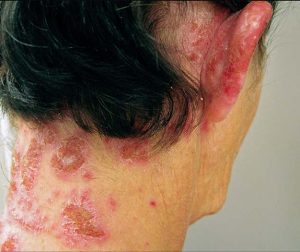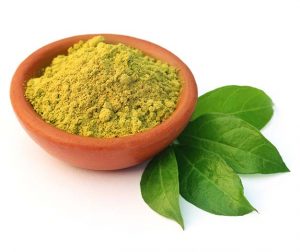Have you ever thought about the risk you are taking when you sit in a hairdresser’s chair while your hair is being coated with a chemical hair dye?
Whether you want to cover a few stray greys or find out if blondes really do have more fun, you’ll need to use a permanent or semi-permanent hair dye to change your hair colour. But if you’re prone to allergies, or even just concerned about absorbing nasty chemicals, you might be worried about what’s in hair dye that makes it work its magic. Hair colour contains chemicals that are known irritants, and rumours still persist that hair dye is linked to cancer.
The Hair Chemicals
To permanently colour the hair, hair dyes use a combination of the chemicals ammonia and hydrogen peroxide.
Hydrogen peroxide works by bleaching out the natural colour and releasing oxygen, which allows chemical reactions to take place. Ammonia works by breaking down the outer cuticle around the hair shaft, allowing the other chemicals to enter the hair, where the colour development can take place.
These chemicals are quite harsh and can harden and thin the hair, and they’re also thought to irritate the skin, eyes and respiratory system.
Other known irritants include:
- Ethanolamine (monoethanolamine, diethanolamine etc), often used as an alternative in ammonia-free products
- Resorcinol, which can sometimes cause allergies and can be irritating
- Sodium lauryl sulfate (SLS), which may dry or irritate your skin
- Parabens, preservatives often questioned for their potential oestrogenic effects. They’re not widely used in hair dye products, so excluding them isn’t a strong selling point
- Lead acetate, found in hair colour restorers rather than dyes. Lead is a neurotoxin and a suspected carcinogen. Studies have found that very little is absorbed into the blood through the scalp, though long-term cumulative effects haven’t been studied. Bismuth citrate is sometimes used instead of lead acetate in hair colour restorers, and is thought to be less toxic
- Para-phenylenediamine (PPD), toluene-2,5-diamine (TD) and toluene-2,5-diamine sulphate (TDS) can cause allergies. Symptoms range from a burning sensation and redness or rash, to weeping blisters, chemical burns and severe swelling of the face. Anaphylactic shock is rare but it happens.
 Allergic Reaction
Allergic Reaction
The symptoms of an allergic reaction to hair dye range from a burning sensation and redness or rash, to weeping blisters, chemical burns and severe swelling of the face. Anaphylactic shock is rare but it can happen. The allergic reaction can occur at any time – from the first time you use dye or suddenly, after many years of trouble-free use. These same allergens can be found in some henna hair products and henna tattoos.
Skin Patch Test for Allergies
Products with these allergens carry warnings and recommend you do a skin sensitivity (patch) test, where a small amount of dye is applied to your forearm or behind the ear. If there is no reaction within 48 hours, it’s presumed you are safe to use it.
However, the EU Scientific Committee on Consumer Products points out that this is no guarantee: there are many misleading and false-negative results, and it can take up to a week to react to the allergen, not 48 hours. They also point out the patch test can actively sensitise people to the allergen, so when they apply the dye to their hair two days later they get an allergic reaction.
Although most people are likely never to develop a hair dye allergy, you can reduce the risk by making sure not to get the dye on your skin, using gloves to apply the dye and making sure you don’t leave the dye on longer than the recommended time.
Hairdressers’ Tip
If you find hair dyes irritating – and it’s definitely not an allergy – leave your hair unwashed for a few days before dying. The natural oils and dirt on the scalp help protect the skin from the irritants.
 Want to Dye Naturally?
Want to Dye Naturally?
All in all, the ingredients in hair dye won’t cause problems for most people, and there’s no evidence they cause permanent harm. But if you do find these ingredients irritating, you can buy products with no or low levels of them.
But be warned, although the packaging may reassure you with images of fruit, plants and other natural goodness, many health store hair dyes still contain plenty of chemicals, including the main allergy culprits.
PPD appears to have the strongest allergenic potential. It is found in most permanent dye products on the market, and it’s also found in some henna products for hair and temporary tattoos.
PPD used to be banned from hair dyes in some European countries, but it’s now considered okay if it comprises less than six per cent of a product. Manufacturers aren’t required to state exactly how much PPD is present and, depending on the colour, the level can vary. There tends to be more PPD in darker dyes.
You could try henna products, including those mixed with indigo for a brown rather than red effect. Senna gives a golden tint to grey or blonde hair. Some plant dye products contain PPD or metallic salts, so check ingredients.
PPD in Henna
Some henna products – especially black or dark henna – contain PPD, and are therefore unsuitable for people with hair dye allergies. If you’re buying henna products because of allergies to conventional hair dyes, check the ingredients carefully.
Serious Side Effects?
In the past, there’s been some concern from health authorities that the chemicals in hair dye could lead to bladder and breast cancer. However, a review of the medical literature published in the Journal of the American Medical Association found there was no increased risk, including for people who dye their hair regularly.
However, some of the ingredients found in hair dye – for example, resorcinol and parabens – are suspected to be endocrine-disrupting chemicals (EDCs). EDCs interfere with the production, action and/or elimination of our naturally present hormones, and are linked to some cancers, reproductive abnormalities and a range of other disorders and conditions.


